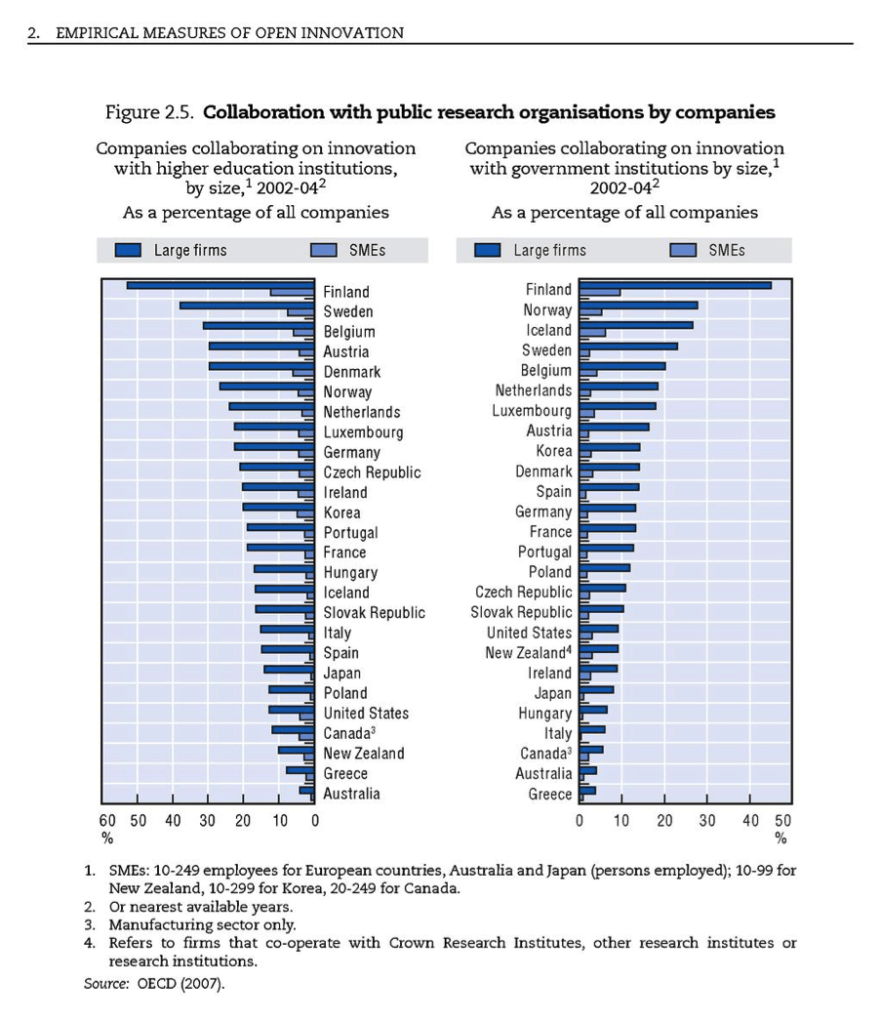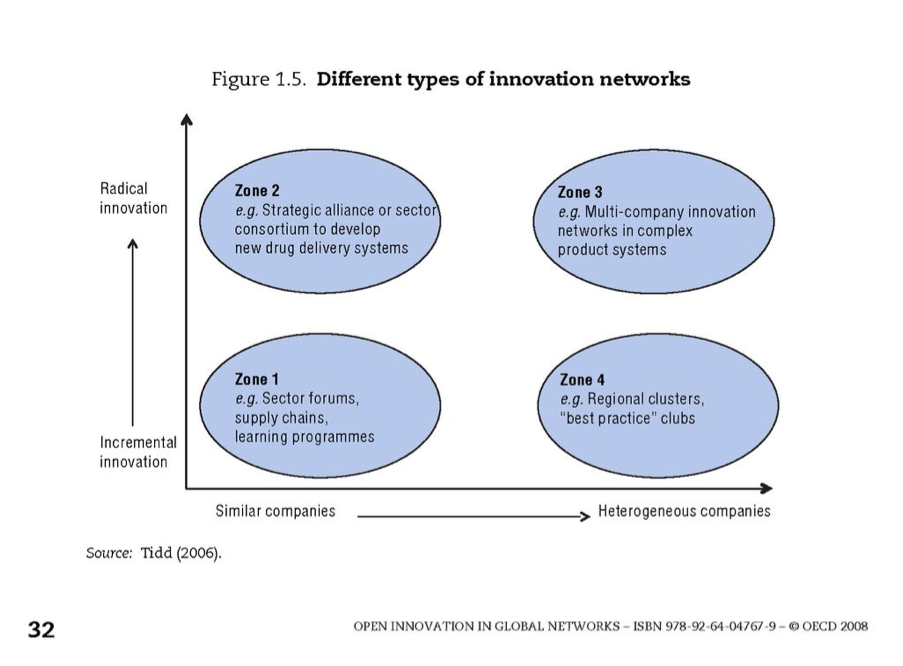National, state, city and local governments are facing an ever-changing world with more complex problems than ever. It is incredibly important for governments to respond to a rapidly growing and interconnected population in its urban cities and to provide services in a sustainable and innovative way. As the World Bank supports its mission of ending poverty, it is crucial that it receives the input of the various stakeholders that are affected by the projects and policies in tries to implement around the world. The World Bank Group has embraced the idea of open innovation as a strategic way forward for itself as an institution, and more largely, the governments it serves and its stakeholders to address these dynamic problems in a systematic way. [1] This is a revolutionary and disruptive step in the decision-making process of traditionally bureaucratic and closed government entities. Government research and innovation institutions are generally more sources of knowledge transfer rather than in-house R&D, which is left mostly to the private sector. [2] There are now innovative challenges held for entrepreneurs in cities like New York, Barcelona and Amsterdam to solve issues such as optimizing public transportation systems, better delivering government services and leveraging new technologies to digitize away red tape. Reykjavik has created a novel grassroots-created digital initiative that illustrates how a fast-moving technology can productively stimulate slower-moving democratic governance. [1] [3] Collaboration through the use of public and private partnerships (PPPs) is more common, but still underutilized outside of Europe. [2]
In the short term, the World Bank has begun to introduce the idea of open innovation to cities and governments for the past three years in Chile, Colombia, Egypt and Mozambique through a systematic methodology designed to engage stakeholders from the top-down as well as bottom- up. [4] They have done this by first identifying “internal champions,” who are government officials that advocate the new technology, as well as external stakeholders organized in an “innovation hub” to create a feedback loop that will eventually lead the way for long-term sustainability and scalability. This innovation hub can be categorized in Zone 4, as for a heterogeneous ecosystem with incremental innovation that typifies governments. [5] This innovation hub is then provided with a methodology to catalyze open innovation, taught through co-design workshops, diagnoses, competitions and co-creation workshops, all of which are iterative. An example can be found in Chile, in the city area of Gran Concepcion where it catalyzed the adoption of the bottom-up smart city model. [4]
The logical next step for the World Bank in supporting these processes in the short to medium-term are to continue to socialize this idea and garner political buy-in from the government officials that will be implementing the eventual solutions. The “internal champions” and external stakeholders will accomplish little if there is lack of political will from the ultimate authority. [6] A challenge facing this type of process improvement is when there needs to be an alignment of incentives and priorities over a diverse set of stakeholders. There is also a need for the World Bank to create regulatory systems that support the entrepreneurial environment and to make the regulatory adjustments that government must make to foster innovation. [5] Challenges also lie within trying to solve problems that have been persistent over time and where no traditional solution has worked. To find solutions you must allow entrepreneurs and non-traditional actors to be included in the process. Good ideas cannot be developed from the bottom-up if there is not a “culture of innovation” that is fostered from the top-down. [5] The World Bank must also continue to adopt this methodology within its own processes. Currently, the World Bank has few opportunities to crowd-source ideas for different development problems, such as gathering youth from around the world to the World Bank Group Youth Summit and engaging in an ideas competition for topics such as education, climate change and technology. This, along with the Ideas for Action, a joint program between the World Bank Group and the Zicklin Center for Business Ethics Research at the Wharton School, Ideas for Action is a knowledge platform and competition for design ideas for financing the UN’s Sustainable Development Goals (SDGs). [7] [8] However, it is unclear how the translation of these ideas to practical policy recommendations and projects has truly affected the decision-making process.
To this end, how effective can the World Bank be at influencing other governments to adopt open innovation practices if they cannot fully utilize the process themselves? Beyond implementation, the World Bank must also guide governments in the monitoring and evaluation systems for such innovation policies, once the process is opened to more and more actors, is it possible to measure its efficacy? (783 words)
Sources
- Mulas, V. (2018). How to implement “open innovation” in city government. [online] Sustainable Cities. Available at: https://blogs.worldbank.org/sustainablecities/how-implement-open-innovation-city-government [Accessed 13 Nov. 2018].
- OECD (2008), “Open Innovation in Global Networks”, in Open Innovation in Global Networks, OECD Publishing, Paris.
- Lackaff, D. (2015). Escaping the Middleman Paradox: Better Reykjavik and Open Policy Innovation. JeDEM – eJournal of eDemocracy and Open Government, [online] 7(2), pp.137-161. Available at: https://jedem.org/index.php/jedem/article/view/386/343.
- World Bank Group (2015). INTRODUCING SUSTAINABLE OPEN INNOVATION IN GOVERNMENT. Applied Methodology for Cities. [online] World Bank Group. Available at: http://documents.worldbank.org/curated/en/666831468179646130/pdf/102761-WP-OUO-9-Box391846B-SCGC-Report-new-upd.pdf [Accessed 13 Nov. 2018].
- Open Innovation in a Global Perspective. (2008). OECD Science, Technology and Industry Working Papers.
- Park, E. and Lee, J. (2015). A study on policy literacy and public attitudes toward government innovation-focusing on Government 3.0 in South Korea. Journal of Open Innovation: Technology, Market, and Complexity, [online] 1(1). [Accessed 13 Nov. 2018].
- Ideas for Action. (2018). Ideas for Action at the 2018 IMF-WBG Annual Meetings. [online] Available at: https://www.ideas4action.org/ideas-for-action-at-the-2018-imf-wbg-annual-meetings/ [Accessed 13 Nov. 2018].
- Voices. (2018). World Bank Group Youth Summit 2016: Rethinking education for the new millennium. [online] Available at: http://blogs.worldbank.org/voices/youth-summit-2016-rethinking-education-new-millennium [Accessed 13 Nov. 2018].
- OECD (2008), “Empirical Measures of Open Innovation”, in Open Innovation in Global Networks, OECD Publishing, Paris.
- Innovation Policy Platform. (2018). Open innovation. [online] Available at: https://www.innovationpolicyplatform.org/content/open-innovation [Accessed 13 Nov. 2018].
The post Opening up the doors of city hall, everywhere appeared first on Technology and Operations Management.
 [6]
[6]